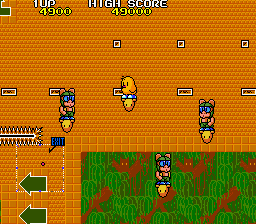Ribbit!
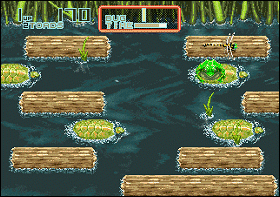 The Game: Two frogs, Bull and Pip, set out on a hazardous journey…to find some flies to eat. They must grab yummy flies while avoiding several lanes of poisonous spider “traffic”, and they also have to cross the occasional river on the backs of turtles and logs, snatching more flies out of the air without falling into the water. Each screen is cleared by the frogs eating the required number of flies. (Sega, 1991)
The Game: Two frogs, Bull and Pip, set out on a hazardous journey…to find some flies to eat. They must grab yummy flies while avoiding several lanes of poisonous spider “traffic”, and they also have to cross the occasional river on the backs of turtles and logs, snatching more flies out of the air without falling into the water. Each screen is cleared by the frogs eating the required number of flies. (Sega, 1991)
Memories: It’s not Frogger. It’s not even officially a sequel to Frogger (by this time, Konami, the originators of that game, had reasserted their ownership rights). But I’ll be croaked if Ribbit! isn’t at least “inspired by” Frogger – how that one didn’t get the lawyers suited up for an amphibious mission, we may never know.
Intergalactic Trade: Mark II
The Game: You must choose wisely from a field of candidates to captain your merchant battleship (as well as picking the ship, which can be upgraded at any port), and survive a series of trading adventures along a route that runs from Earth’s sun to Alpha Centauri. In the long empty stretches of space between Pluto’s orbit and Alpha Centauri, there are no resupply/repair outposts – and there are plenty of attacking pirates. Sample passing comets to mine a rare element that will improve the aim of your weapons…and watch out for the Borg. Planetside, you can buy and sell your goods, upgrade your ship, recruit additional crew members, or visit the casino in an effort to increase your funds. Your captain ages as the game progresses (long space hauls still take a while in this universe despite warp drive), and will eventually die – so don’t let yourself run out of crewmembers. (Earl Green & Robert Heyman, 1990)

Memories: I recently stumbled across the 5 1/4″ floppy containing Intergalactic Trade: Mark II while doing an entire Saturday of Apple II game screen stills, and I was floored. I had completely forgoten about this game, or how far we’d gotten into the process of programming it in our senior year of high school.
And nowhere in my wildest dreams did I imagine that it was as much fun as it is.

Borrowing its basic structure from Taipan!, Intergalactic Trade: Mark II incorporated Star Trek terminology (warp speed, phasers, etc., as well as one-in-a-million surprise attacks by the Borg), Jump Cut City placenames (which makes sense as we were still enamoured of the idea of producing our own little TV show at that time), very scratchy screen stills from Blake’s 7 for the intro and instruction screens, and even a few elements of Dungeons & Dragons and Ultima IV for good measure. In short, you can easily tell what we were watching and playing at the time we came up with this game.

In a somewhat more modernized setting than Taipan, we reasoned that there would be businesses set up at every port to upgrade shields and weapons. And in an admittedly Star Trek-inspired move, combat situations can be solved by negotiation…every once in a while. Your ability to talk your way out of a fight is influenced heavily by the randomly-generated statistics of your captain character; his age, his status (which can range from “hated” to “unknown” to “legendary”) and his charisma all come into play there. If beaten, an enemy ship’s crew may mutiny and offer your their services (and their captain’s cargo) to stay alive; showing mercy to too few enemies will, in an Ultima-esque fashion, start to erode your captain’s reputation.

In eleven years, I’d completely forgotten that I had worked on this game in my late teens. I actually find it rather addictive now – yes, it is all text and statistics, and there are still some rough edges that I may go back and try to fix up later. Or who knows? I may try to port this into something more modern – perhaps even a simple web-based game. I’m quite happy with Intergalactic Trade: Mark II (though I don’t remember what on earth happened to Mark I).

I went through the BASIC code and found that the casino odds were heavily weighted in favor of the house; not only a realistic touch, but, like Wil Wright and Richard Garriott, I was dead guilty of working my own beliefs and worldview into the game. Gambling was no way to advance yourself in the universe – indeed, spending too much time gambling also cost you points on your reputation.
Wow. My very own Phosphor Dot Fossil. Too darn cool.

This game is still a work in progress and I’m working on making what there is of the game available as a disk image; keep checking back to this page. If there’s enough interest, I may do a limited run of actual floppies with accompanying documentation, though before going there, I’d very much like to finish the game first. – EG
Lock ‘N’ Chase
 The Game: You’re in charge of a getaway car loaded with crafty criminals. Your job is to sneak around the maze, avoid a bunch of cranky cops who are hot on your trail, and grab all the dough – and, of course, to escape so you can steal again another day. But the cops can trap you with a series of doors that can prevent you from getting away… (Data East, 1990)
The Game: You’re in charge of a getaway car loaded with crafty criminals. Your job is to sneak around the maze, avoid a bunch of cranky cops who are hot on your trail, and grab all the dough – and, of course, to escape so you can steal again another day. But the cops can trap you with a series of doors that can prevent you from getting away… (Data East, 1990)
Memories: After a quick “training” chase in a small maze – presumably in the vault while you’re making the big heist – the Game Boy version of Lock ‘N’ Chase is somewhat faithful to the original, even though it “zooms in” on the section of the maze surroundng your bank robber. However, while the original arcade game was an obvious attempt to get in on Pac-Man‘s maze-chase, dot-gobbling action without aping every aspect of the game, Lock ‘N’ Chase on the Game Boy makes the comparison obvious.
Revenge Of Defender
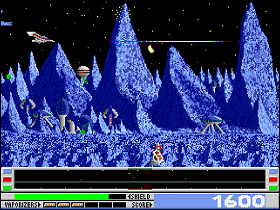 The Game: Players slide into the cockpit of Defender once again, defending the power generators on the surface of a human space colony from intruding aliens. As usual, the Defender is a versatile, fast-moving attack ship, but the aliens have an advantage in sheer numbers. Vaporizer bombs can clear the screen of attackers, but they’re in short supply. Eliminating all invaders clears the level and starts anew; running out of Defender craft means the aliens win. (Ensign Software, 1989)
The Game: Players slide into the cockpit of Defender once again, defending the power generators on the surface of a human space colony from intruding aliens. As usual, the Defender is a versatile, fast-moving attack ship, but the aliens have an advantage in sheer numbers. Vaporizer bombs can clear the screen of attackers, but they’re in short supply. Eliminating all invaders clears the level and starts anew; running out of Defender craft means the aliens win. (Ensign Software, 1989)
Memories: Among the most obscure offshoots of the Defender family tree spawned by the 1980 coin-op, Revenge Of Defender is a dressed-up PC remake of the classic game, trading the complicated control scheme and uncluttered graphics of the original for a easier player controls and background graphics that actually get in the way of the game.
Q*Bert
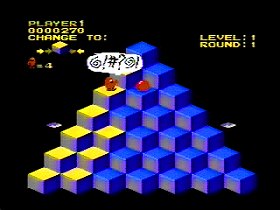 The Game: Q*Bert, a nosey little guy with a propensity for hopping, spends his time hopping around a three-dimensional pyramid of cubes, avoiding Coily the Snake and other assorted purple and red creatures, including a few who operate on a slightly different plane (i.e., they move down the pyramid as if it were rotated one-third). Any green objects and creatures Q*Bert can catch will not hurt him – in fact, the little bouncing green balls will stop time briefly for everyone but Q*Bert. If he gets into a tight spot, Q*Bert can jump off the pyramid onto a flying disc which will despoit him back at the top of the pyramid – and lure Coily to a nasty fate by jumping into nothing. Changing the colors of the top of every cube in the pyramid to the target color indicated at the top left of the screen will clear the pyramid and start the craziness all over again. If Q*Bert is hit by an enemy or falls off the pyramid, he hits bottom with a resounding, arcade- cabinet-shaking splat and a burst of incomprehensible obscenity! (Konami/Ultra, 1989)
The Game: Q*Bert, a nosey little guy with a propensity for hopping, spends his time hopping around a three-dimensional pyramid of cubes, avoiding Coily the Snake and other assorted purple and red creatures, including a few who operate on a slightly different plane (i.e., they move down the pyramid as if it were rotated one-third). Any green objects and creatures Q*Bert can catch will not hurt him – in fact, the little bouncing green balls will stop time briefly for everyone but Q*Bert. If he gets into a tight spot, Q*Bert can jump off the pyramid onto a flying disc which will despoit him back at the top of the pyramid – and lure Coily to a nasty fate by jumping into nothing. Changing the colors of the top of every cube in the pyramid to the target color indicated at the top left of the screen will clear the pyramid and start the craziness all over again. If Q*Bert is hit by an enemy or falls off the pyramid, he hits bottom with a resounding, arcade- cabinet-shaking splat and a burst of incomprehensible obscenity! (Konami/Ultra, 1989)
Memories: Ah, the eternal conundrum of Q*Bert – to turn the controller, or try to do diagonals with an NES joypad? The original arcade incarnation of the mighty orange one solved the problem pretty simply by turning a standard four-directional joystick at a 45-degree angle within the coin-op’s casing. To truly replicate that effect, you’re given the option of rotating the NES controller 45 degrees or to try to do diagonals while holding it straight (in effect, hitting the left and down portions of the plus-shaped pad simultaneously to move in that direction). There’s a whole pre-game startup screen devoted to controller orientation here. And as awkward as it is, the 45-degree angle option is much more responsive on the NES. Now, a joystick such as the Advantage may help here, but again, the hardware itself dictates that the controller won’t be as responsive diagonally.
 The Game: As a daring spy, you break into a top secret enemy facility, trying to grab vital secrets and evade or kill as many enemy agents as you can. Your only means of getting from floor to floor through most of the game is via the elevator – which gives you an advantage and also makes you vulnerable. (Taito, 1991)
The Game: As a daring spy, you break into a top secret enemy facility, trying to grab vital secrets and evade or kill as many enemy agents as you can. Your only means of getting from floor to floor through most of the game is via the elevator – which gives you an advantage and also makes you vulnerable. (Taito, 1991) The Game: You are a marker, trying to claim as much of the playing field as you can by enclosing areas of it. Drawing your boundaries faster is safer, but yields fewer points. A slower draw, which leaves you vulnerable to attack from the Qix and the Sparx, gives you many more points upon the completion of an enclosed area. If the ever-shifting Qix touches your marker or an uncompleted boundary you are drawing, you lose a “life” and start again. And the Sparx, which travel only along the edges of the playing field and along the boundaries of areas of the screen you’ve already enclosed, can destroy you by touching your marker. And if you linger too long, a fuse will begin burning at the beginning of your unfinished boundary, and will eventually catch up with you. (Nintendo/Taito, 1990)
The Game: You are a marker, trying to claim as much of the playing field as you can by enclosing areas of it. Drawing your boundaries faster is safer, but yields fewer points. A slower draw, which leaves you vulnerable to attack from the Qix and the Sparx, gives you many more points upon the completion of an enclosed area. If the ever-shifting Qix touches your marker or an uncompleted boundary you are drawing, you lose a “life” and start again. And the Sparx, which travel only along the edges of the playing field and along the boundaries of areas of the screen you’ve already enclosed, can destroy you by touching your marker. And if you linger too long, a fuse will begin burning at the beginning of your unfinished boundary, and will eventually catch up with you. (Nintendo/Taito, 1990)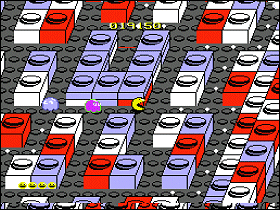 The Game: As a round yellow creature consisting of a mouth and nothing else, you maneuver around relatively simple mazes, gobbling small dots and evading five colorful monsters who can eat you on contact. In four corners of the screen, larger dots enable you to turn the tables and eat the monsters for a brief period. Periodically, assorted items appear near the center of the maze, and you can consume these for additional points as well. The monsters, once eaten, return to their home base in ghost form and return to chase you anew. If you clear the maze of dots, you advance to a new maze and the game starts again, but just a little bit faster… (Tengen, 1990)
The Game: As a round yellow creature consisting of a mouth and nothing else, you maneuver around relatively simple mazes, gobbling small dots and evading five colorful monsters who can eat you on contact. In four corners of the screen, larger dots enable you to turn the tables and eat the monsters for a brief period. Periodically, assorted items appear near the center of the maze, and you can consume these for additional points as well. The monsters, once eaten, return to their home base in ghost form and return to chase you anew. If you clear the maze of dots, you advance to a new maze and the game starts again, but just a little bit faster… (Tengen, 1990)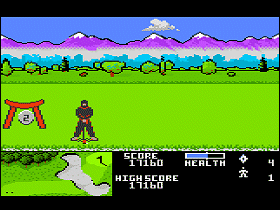 The Game: You face a test of your skills in the time-honored way of the Ninja: you must survive a game of golf. But you’re not the only Ninja on the course, and apparently you are the only Ninja who’s got a bullseye painted on his back. Before you can say “Crouching Tiger Woods, Hidden Dragon,” you must fend off attackers, including pesky gophers and alarmingly large frogs, in between putts. When you reach the green, a large dragon will attack you, as large dragons are wont to do on the green. Defeat the dragon and you advance to the next hole; do not defeat the dragon, and it will leave a hole in you. (Atari, 1990)
The Game: You face a test of your skills in the time-honored way of the Ninja: you must survive a game of golf. But you’re not the only Ninja on the course, and apparently you are the only Ninja who’s got a bullseye painted on his back. Before you can say “Crouching Tiger Woods, Hidden Dragon,” you must fend off attackers, including pesky gophers and alarmingly large frogs, in between putts. When you reach the green, a large dragon will attack you, as large dragons are wont to do on the green. Defeat the dragon and you advance to the next hole; do not defeat the dragon, and it will leave a hole in you. (Atari, 1990)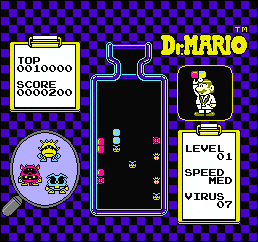 The Game: Now that he’s got plumbing and rescuing princesses out of the way, Mario ‘s gone and finished his medical degree. You have to help him dish out just the right pills to get rid of the corresponding viruses, matching them by color. Stacking at least three pill segments of the same color on top of or next to a virus will kill it, but the leftover pill segments will fall into place, possibly keeping you from treating other problems. (Mismatched pills can be eliminated too, by creating a stack of four segments of the same color.) Allowing too many pills to clog the works will end the game. (Nintendo, 1990)
The Game: Now that he’s got plumbing and rescuing princesses out of the way, Mario ‘s gone and finished his medical degree. You have to help him dish out just the right pills to get rid of the corresponding viruses, matching them by color. Stacking at least three pill segments of the same color on top of or next to a virus will kill it, but the leftover pill segments will fall into place, possibly keeping you from treating other problems. (Mismatched pills can be eliminated too, by creating a stack of four segments of the same color.) Allowing too many pills to clog the works will end the game. (Nintendo, 1990)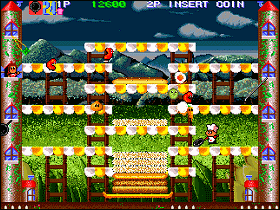 The Game: Chef Peter Pepper is back, and boy, is he kawaii. As in the original Burgertime, the chef has to climb ladders and cross levels – while being chased by deadly ingredients – all in the pursuit of building the perfect giant burger. If he drops the burger on them, the chef’s opponents can become part of the meal. He can also spray them with pepper, as in the original game, or grab bonus weapons (such as a frying pan with which to brain them) from the sides of the screen when they intermittently appear. If enemies are on a bun, patty, etc. when it’s dropped, they’re temporarily taken out of play. Players advance a level by completing construction of all of the burgers. (Data East, 1988?)
The Game: Chef Peter Pepper is back, and boy, is he kawaii. As in the original Burgertime, the chef has to climb ladders and cross levels – while being chased by deadly ingredients – all in the pursuit of building the perfect giant burger. If he drops the burger on them, the chef’s opponents can become part of the meal. He can also spray them with pepper, as in the original game, or grab bonus weapons (such as a frying pan with which to brain them) from the sides of the screen when they intermittently appear. If enemies are on a bun, patty, etc. when it’s dropped, they’re temporarily taken out of play. Players advance a level by completing construction of all of the burgers. (Data East, 1988?) The Game: Cavernous rooms are loaded with gold, just ripe for the picking. But before you celebrate hitting the mother lode, look again – there are other gold-diggers homing in on the treasure. What do you have that they don’t? A drill gun that can blast a hole in the floors, into which your opponents will jump blindly. Eventually, the holes will reseal themselves, and that process will swallow your enemies (and you, if you happen to be clumsy enough to wander into the hole yourself). Grabbing all of the gold will reveal a passage to the next level of the game. (Bandai, 1989)
The Game: Cavernous rooms are loaded with gold, just ripe for the picking. But before you celebrate hitting the mother lode, look again – there are other gold-diggers homing in on the treasure. What do you have that they don’t? A drill gun that can blast a hole in the floors, into which your opponents will jump blindly. Eventually, the holes will reseal themselves, and that process will swallow your enemies (and you, if you happen to be clumsy enough to wander into the hole yourself). Grabbing all of the gold will reveal a passage to the next level of the game. (Bandai, 1989) The Game: As intrepid plumber (and explorer) Mario, players have to jump through new environments and enemies to help Mario rescue Daisy. Egyptian pyramids guarded by fire-breathing Sphinxes, seaside platforms invaded by space aliens, and the usual Goombas and Koopas await Mario as he tries to reach the end of each level. As always, there are mushrooms, stars and fire flowers to help Mario power up, and helpful hidden chambers full of coins. (Nintendo, 1989)
The Game: As intrepid plumber (and explorer) Mario, players have to jump through new environments and enemies to help Mario rescue Daisy. Egyptian pyramids guarded by fire-breathing Sphinxes, seaside platforms invaded by space aliens, and the usual Goombas and Koopas await Mario as he tries to reach the end of each level. As always, there are mushrooms, stars and fire flowers to help Mario power up, and helpful hidden chambers full of coins. (Nintendo, 1989)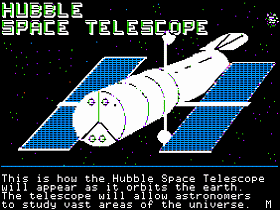 The Game: Well, it’s not really a game. A NASA-published electronic press kit walks you through the basics of the then-upcoming
The Game: Well, it’s not really a game. A NASA-published electronic press kit walks you through the basics of the then-upcoming  The Game: Captain Picard places Commander Riker – that’s you, by the way – in charge of the Enterprise, which is currently on a mission to find out who is launching terrorist attacks on mining stations in the Aquila solar system. Riker can use the Enterprise’s computer to analyze objects and ships, or to look up Federation data files on the various people involved in the growing conflict. And of course, he can call upon the knowledge and experience of his crewmates for advice, or bring them along as he beams down to the various locales on each planet or asteroid in the game. One thing not at Riker’s disposal is time: the attacks continue, and whoever is mounting the attacks is getting bolder with each attempt. And someone in the Aquila system knows more than they’re telling. (Simon & Schuster Interactive, 1989)
The Game: Captain Picard places Commander Riker – that’s you, by the way – in charge of the Enterprise, which is currently on a mission to find out who is launching terrorist attacks on mining stations in the Aquila solar system. Riker can use the Enterprise’s computer to analyze objects and ships, or to look up Federation data files on the various people involved in the growing conflict. And of course, he can call upon the knowledge and experience of his crewmates for advice, or bring them along as he beams down to the various locales on each planet or asteroid in the game. One thing not at Riker’s disposal is time: the attacks continue, and whoever is mounting the attacks is getting bolder with each attempt. And someone in the Aquila system knows more than they’re telling. (Simon & Schuster Interactive, 1989)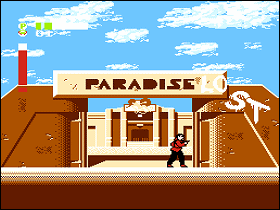 The Game: Sybok, a charismatic Vulcan cult leader, has tried to disrupt the peace process on the neutral planet Nimbus III. Players take control of one Enterprise crewman at a time to: retrieve the Nimbus III hostages (Sulu), save Kirk and Spock from a cell aboard the Enterprise (Scotty), pilot the Enterprise through asteroids and attacking Klingons (Sulu again?), and finally make a mad dash into the heart of the lair of the “god creature” (Kirk). Running out of life energy aborts the mission; fortunately, Dr. McCoy is standing by at all times and the mission can start from scratch. (Bandai, 1989 – unreleased)
The Game: Sybok, a charismatic Vulcan cult leader, has tried to disrupt the peace process on the neutral planet Nimbus III. Players take control of one Enterprise crewman at a time to: retrieve the Nimbus III hostages (Sulu), save Kirk and Spock from a cell aboard the Enterprise (Scotty), pilot the Enterprise through asteroids and attacking Klingons (Sulu again?), and finally make a mad dash into the heart of the lair of the “god creature” (Kirk). Running out of life energy aborts the mission; fortunately, Dr. McCoy is standing by at all times and the mission can start from scratch. (Bandai, 1989 – unreleased)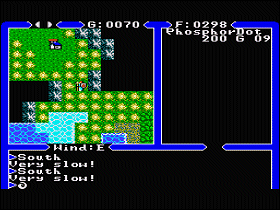 The Game: Darkness has fallen anew upon Britannia, and Lord British calls for your service again. You start out alone, accumulating traveling (and fighting) companions along your journey, striving to live by the Eight Virtues that govern conduct in the kingdom. Along the way, numerous creatures, both evil and simply pesky, challenge you. As you go forth on the quest, you must also collect the mantras of each Virtue, travel to the corresponding Shrines, and meditate there until you reach enlightenment. With enlightenment and experience come the strength to rid Britannia of evil – but beware the dark side… (Sega / Origin Systems, 1989)
The Game: Darkness has fallen anew upon Britannia, and Lord British calls for your service again. You start out alone, accumulating traveling (and fighting) companions along your journey, striving to live by the Eight Virtues that govern conduct in the kingdom. Along the way, numerous creatures, both evil and simply pesky, challenge you. As you go forth on the quest, you must also collect the mantras of each Virtue, travel to the corresponding Shrines, and meditate there until you reach enlightenment. With enlightenment and experience come the strength to rid Britannia of evil – but beware the dark side… (Sega / Origin Systems, 1989) The Game: A worm-like dragon taunts you from atop a multi-colored wall, one which you must topple to reunite your divided village. To accomplish this task, you must bounce hurled projectiles into the wall. Collecting power-ups along the way will affect the behavior of the projectile, from making it a weapon capable of wiping out large portions of the wall to making it return to you repeatedly, like a boomerang. You advance to the next level by eliminating the wall. (Atari, 1989)
The Game: A worm-like dragon taunts you from atop a multi-colored wall, one which you must topple to reunite your divided village. To accomplish this task, you must bounce hurled projectiles into the wall. Collecting power-ups along the way will affect the behavior of the projectile, from making it a weapon capable of wiping out large portions of the wall to making it return to you repeatedly, like a boomerang. You advance to the next level by eliminating the wall. (Atari, 1989)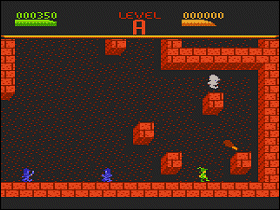 The Game: You control a lone adventurer on a quest through twisty mazes and open battlegrounds, descending through the dungeon depths in search of treasure (and a chance to escape in one piece with that treasure in hand). Zombies, ghosts, and monsters naturally roam through the dungeons as well, more than happy to attack any treasure-hunting interlopers such as yourself. (Atari, 1988)
The Game: You control a lone adventurer on a quest through twisty mazes and open battlegrounds, descending through the dungeon depths in search of treasure (and a chance to escape in one piece with that treasure in hand). Zombies, ghosts, and monsters naturally roam through the dungeons as well, more than happy to attack any treasure-hunting interlopers such as yourself. (Atari, 1988) The Game: Baseball returns to the small screen – the very small screen – on the Game Boy. Step up to the plate and take a swing; after three outs, take control of the pitcher, basemen and outfield, trying to keep the computer from scoring a run. (Nintendo, 1989)
The Game: Baseball returns to the small screen – the very small screen – on the Game Boy. Step up to the plate and take a swing; after three outs, take control of the pitcher, basemen and outfield, trying to keep the computer from scoring a run. (Nintendo, 1989)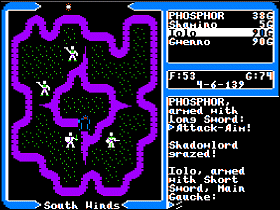 The Game: Darkness has fallen upon the land of Britannia. Lord Blackthorn, with the help and manipulation of the evil Shadowlords, has taken over, banishing Lord British from his own kingdom and ruling over the world with an iron first. Having settled into a little house in the woods after your ascension to Avatar, you are called upon once more to set things right. An underground resistance movement is quietly biding its time, waiting for Lord British to return, and hailing you and your friends as its heroes. But there are also many who have fallen in line behind Blackthorn and his dark masters – and would be happy to dispose of the Avatar for him. (Origin Systems, 1988)
The Game: Darkness has fallen upon the land of Britannia. Lord Blackthorn, with the help and manipulation of the evil Shadowlords, has taken over, banishing Lord British from his own kingdom and ruling over the world with an iron first. Having settled into a little house in the woods after your ascension to Avatar, you are called upon once more to set things right. An underground resistance movement is quietly biding its time, waiting for Lord British to return, and hailing you and your friends as its heroes. But there are also many who have fallen in line behind Blackthorn and his dark masters – and would be happy to dispose of the Avatar for him. (Origin Systems, 1988) The Game: You’re an intrepid X-Wing pilot participating in the last-ditch Rebel attempt to destroy the Death Star – before it destroys the Rebel base on Yavin IV. TIE Fighters try to intercept you, but you can destroy them (as well as use your own lasers to blast their incoming fire out of the sky). Then you move in to attack the Death Star itself, with its incredibly hazardous system of gunnery towers and bunkers. Once you’ve gotten past the surface defenses, you dive into the trench that will lead you to an exhaust port which is the only means of destroying the Death Star – but there are defenses in the trench as well, and your deflector shields can only take so much… (Domark / Zeppelin Games Ltd., 1988)
The Game: You’re an intrepid X-Wing pilot participating in the last-ditch Rebel attempt to destroy the Death Star – before it destroys the Rebel base on Yavin IV. TIE Fighters try to intercept you, but you can destroy them (as well as use your own lasers to blast their incoming fire out of the sky). Then you move in to attack the Death Star itself, with its incredibly hazardous system of gunnery towers and bunkers. Once you’ve gotten past the surface defenses, you dive into the trench that will lead you to an exhaust port which is the only means of destroying the Death Star – but there are defenses in the trench as well, and your deflector shields can only take so much… (Domark / Zeppelin Games Ltd., 1988) The Game: As the commander of a sleek Solvalou fighter, you’re deep into enemy territory, shooting their disc-shaped fighters out of the sky, bombing ground installations and artillery nests, bombing tanks, and trying to destroy the
The Game: As the commander of a sleek Solvalou fighter, you’re deep into enemy territory, shooting their disc-shaped fighters out of the sky, bombing ground installations and artillery nests, bombing tanks, and trying to destroy the 
 The Game: Mappy the Mouse is back, pursuing his feline arch nemesis Boss The Big Bit and his kitty kohorts through several themed zones of an amusement park. Riddled with ladders, trampolines, secret weapons and treasures, the park goes from wild west to tropical and beyond. Just avoid the cats, lest Mappy become someone’s mousy morsel. (Taxan [under license from Namco], 1988)
The Game: Mappy the Mouse is back, pursuing his feline arch nemesis Boss The Big Bit and his kitty kohorts through several themed zones of an amusement park. Riddled with ladders, trampolines, secret weapons and treasures, the park goes from wild west to tropical and beyond. Just avoid the cats, lest Mappy become someone’s mousy morsel. (Taxan [under license from Namco], 1988) The Game: It is the year 2XXX (don’t worry, we couldn’t find it on our calendars either), and Planet X has declared war on Earth’s solar system, sending its finest kaiju into the fray. In this time of our most desperate need, Godzilla and Mothra step forward to defend the Earth and fight for humanity, taking out enemy installations, spacecraft and even those pesky enemy monsters. But even Godzilla and Mothra can only take so much damage… (Toho Studios/Nintendo, 1988)
The Game: It is the year 2XXX (don’t worry, we couldn’t find it on our calendars either), and Planet X has declared war on Earth’s solar system, sending its finest kaiju into the fray. In this time of our most desperate need, Godzilla and Mothra step forward to defend the Earth and fight for humanity, taking out enemy installations, spacecraft and even those pesky enemy monsters. But even Godzilla and Mothra can only take so much damage… (Toho Studios/Nintendo, 1988)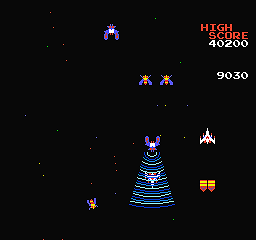 The Game: Commanding a small fleet of sleek fighter ships, you’re up against an alien invasion, arriving in wave after unfriendly wave. Alien fighters resemble butterflies and bees, but the real prize is the handful of motherships which arrives with each wave. Capable of taking two hits – the first weakens them and turns them dark blue, the second destroys them – the motherships also come equipped with a tractor beam with which to snare your fighters. But if one of your fighters is captured, and you can destroy the mothership which is towing it, your wayward fighter will be returned, doubling your firepower. (Bandai, 1988)
The Game: Commanding a small fleet of sleek fighter ships, you’re up against an alien invasion, arriving in wave after unfriendly wave. Alien fighters resemble butterflies and bees, but the real prize is the handful of motherships which arrives with each wave. Capable of taking two hits – the first weakens them and turns them dark blue, the second destroys them – the motherships also come equipped with a tractor beam with which to snare your fighters. But if one of your fighters is captured, and you can destroy the mothership which is towing it, your wayward fighter will be returned, doubling your firepower. (Bandai, 1988)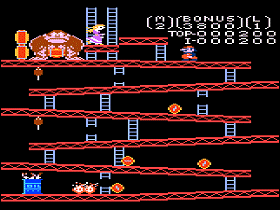 The Game: An oversized gorilla kidnaps Mario’s girlfriend and hauls her up to the top of a building which is presumably under construction. You are Mario, dodging Donkey Kong’s never-ending hail of rolling barrels and “foxfires” in your attempt to climb to the top of the building and topple Donkey Kong. You can actually do this a number of times, and then the game begins again with the aforementioned girlfriend in captivity once more. (Atari, 1988)
The Game: An oversized gorilla kidnaps Mario’s girlfriend and hauls her up to the top of a building which is presumably under construction. You are Mario, dodging Donkey Kong’s never-ending hail of rolling barrels and “foxfires” in your attempt to climb to the top of the building and topple Donkey Kong. You can actually do this a number of times, and then the game begins again with the aforementioned girlfriend in captivity once more. (Atari, 1988) Memories: Before Nintendo made its own inroads in the American home video game market, it happily let homegrown companies take the license and run with it. Coleco won the license for Donkey Kong for the cartridge-based console market, while Atari snagged the rights to release Donkey Kong for various computer systems. When Coleco folded (after the expensive Adam Computer debacle), Atari did the corporate equivalent of going through Coleco’s wallet and picking up its licenses.
Memories: Before Nintendo made its own inroads in the American home video game market, it happily let homegrown companies take the license and run with it. Coleco won the license for Donkey Kong for the cartridge-based console market, while Atari snagged the rights to release Donkey Kong for various computer systems. When Coleco folded (after the expensive Adam Computer debacle), Atari did the corporate equivalent of going through Coleco’s wallet and picking up its licenses.  The Game: Batter up! We’re live from the baseball diamond with TV sports-style camera angles that switch to show you where the action is. (Absolute, 1988)
The Game: Batter up! We’re live from the baseball diamond with TV sports-style camera angles that switch to show you where the action is. (Absolute, 1988)